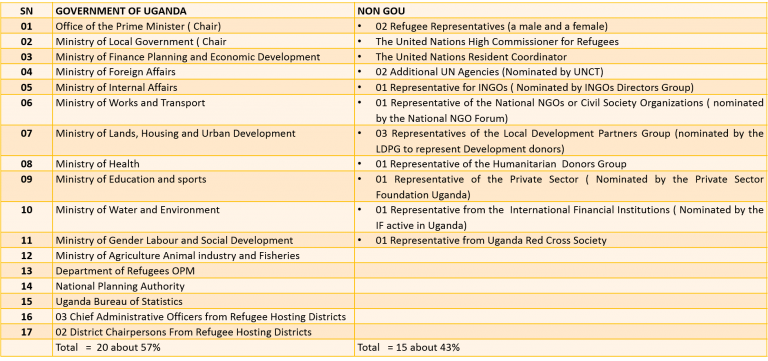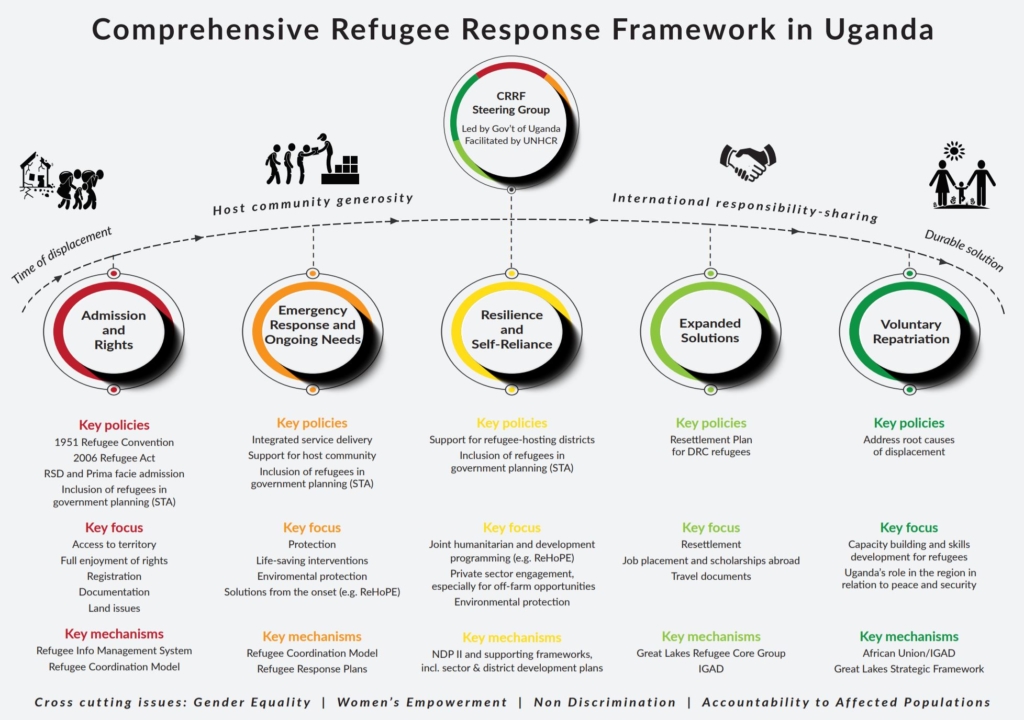WHAT IS THE CRRF?
- The Office of the Prime Minister (OPM) officially launched the Comprehensive Refugee Response Framework on 24th March 2017, adapting the principles and objectives set out in Annex 1 of the New York Declaration of Refugees and Migrants to the Ugandan context. The CRRF is a multi-stakeholder coordination model on refugee matters focusing on humanitarian and development needs of both refugees and host communities.The CRRF in Uganda encompasses five mutually reinforcing pillars as outlined by the global objectives: (i) Admission and Rights, (ii)Emergency Response and Ongoing Needs, (iii) Resilience and Self-reliance, (iv) Expanded Solution and (v) Voluntary Repatriation.
HOW WILL IT BE ACHIEVED?
To better support refugees and the communities hosting them, the New York Declaration calls on Humanitarian and Development actors in refugee response to work together in a more cohesive and predictable approach to refugee response. These actors include not just governments, NGOs, refugees and other UN agencies, but also the private sector, international financial institutions and civil society, including think tanks, academia and faith leaders.
Together, they aim to:
- Ease pressure on countries that welcome and host refugees,
- Build self-reliance of refugees,
- Expand access to resettlement in third countries and other complementary pathways,
- Foster conditions that enable refugees voluntarily to return to their home countries.
This new approach envisions a world where refugees have access to countries where they are safe, where they are better included, where they are no longer living in camps and are not dependent on humanitarian assistance only.
WHO IS RESPONSIBLE FOR CRRF?
In line with the ‘whole of society’ approach, outlined in the New York Declaration, the rollout of the CRRF is Government-led, spearheaded by the Office of the Prime Minister (OPM), facilitated by UNHCR, and guided by the participation of a wide range of stakeholders. To promote coordination between, and help strengthen, existing government and partner institutions, a Steering Group and a Secretariat have been set up to support the application of the CRRF locally.
THE CRRF STEERING GROUP
The CRRF Steering Group (SG) which is the decision-making body of the Comprehensive Refugee Response Framework is co-chaired by the Minister for Disaster Preparedness, Relief and Refugees and the Minister of Local Government.
The Steering Group consists of some 35 members, with 20 seats being held by the Government (MDAs and Local Governments) engaged in the refugee response and 15 seats by non-government of Uganda agencies. These include the representatives of UN agencies, development and humanitarian donors, 2 elected refugee representatives, 1 representative for each of the International and National non-governmental organizations (NGOs), the Private Sector and International Financial Institutions. Representation is decided through nominations from within existing structures and coordination mechanisms. Attendance is at the Heads of Agency level or delegate. The SG meets on a quarterly basis, and five SG meetings have so far been held to guide the coordination of CRRF in Uganda.
Following its inaugural sitting meeting in October 2017, the CRRF Steering Group sat six times in 2018 (including an extraordinary meeting in November 2018), strategically steering CRRF implementation in Uganda.
Table: Current Composition of the CRRF Steering Group

THE CRRF SECRETARIAT
The CRRF Secretariat was constituted and capacitated in February 2018. In line with the Terms of Reference (TORs) listed below, the Secretariat supports coordinated planning, programming and resourcing of the CRRF roll-out in Uganda and ensures cross pillar information flow and linkages. In terms of the operational response, it relies on existing coordination structures and pursues coherence across the various structures.
CRRF Secretariat functions and deliverables presented in the Roadmap include;
Provide support to planning and monitoring of the comprehensive refugee response;
Support analytical work in support of the implementation of a comprehensive refugee response;
Knowledge management in support of the implementation of a comprehensive refugee response, in close consultation with stakeholders;
Support the established mechanism (under Ministry of Finance) to track resources available for a comprehensive refugee response in Uganda, and assisted in the monitoring and tracking of progress, in close consultation with stakeholders;
Advise on needed advocacy, engagement and information-sharing in support of the implementation of a comprehensive refugee response;
In addition to the above tasks, the Secretariat supports the CRRF Steering Group in the preparation of Steering Group meetings; in organizing different meetings/workshops/fora and stakeholder gatherings in Uganda to ensure information sharing and encouraging new partnerships. The Secretariat liaises with all actors including line ministries, humanitarian and development partners, District Local Governments and the beneficiaries.
The Secretariat is headed by Director CRRF, the Under-Secretary for Disaster & Refugees in the Office of the Prime Minister. In line with the spirit of the CRRF, the Secretariat has benefited from both National and International secondments to create a multi-skilled team with the right mix to implement and follow up the decisions of the Steering Group.
WHAT ARE THE KEY MESSAGES?
The broad key messages for all the defined target audiences are;
- Uganda’s refugee response model, of welcoming our brothers and sisters in the hour of need remains intact. It is not only the humane thing to do but it is the right thing to do.
- Uganda has a progressive refugee model: Open borders, non-camp policies, free integration of refugees, equal access to government-provided social services, a chance to work and land allocation for farming and shelter. This model is lauded as the most generous in the world.
- The task is too big for one country, one community or one sector. All hands together, everyone has a role to play. Immense support has been received from the partners towards Uganda’s refugee response. However, Uganda’s refugee response remains chronically underfunded.
WHAT HAS BEEN ACHIEVED SO FAR?
- Establishment of the CRRF Steering Group which is co-chaired by Office of the Prime Minister and Ministry of Local Government. The Steering Group comprises of 35 members representing key stakeholders in Uganda’s refugee response including two representatives from the refugee community;
- Uganda’s CRRF Road Map was adopted at the 2nd CRRF Steering Group meeting on 31st January 2018. This key document provides guidance for CRRF implementation until 2020 by clearly defining common milestones and deliverables to advance key expected results;
- A fully functioning CRRF Secretariat under the Office of the Prime Minister with staffing secondments from Government, The UN, NGOs and other development partners is now in place;
- The Refugee Engagement Forum (REF) established to ensure refugees are effectively represented at the CRRF Steering Group by leadership has been setup and is fully operational;
- The Education Response Plan was launched on 14th September 2018 by the Ministry of Education and Sports;
- The Health Integrated Refugee Response Plan was launched by the Ministry of Health on 25th January 2019;
- The Communications and Outreach Strategy 2018-2020 was adopted by the Steering Group on 18th October 2018 to build a common understanding and vision of the CRRF at all levels;
- An Integrated information portal has been developed: ugandarefugees.org;
- Verification of refugees in Uganda: 1.2 million refugees and asylum seekers have been biometrically verified with support from UNHCR and Government of Uganda;
WHAT ARE THE CONSTRAINING FACTORS?
- The CRRF has been confused with other frameworks hence the development of the Communications and Outreach Strategy to create awareness on how the CRRF reinforces the earlier frameworks in support of Uganda’s refugee model;
- Whereas building the capacity of the local responders is one of the sustainable ways of preparedness, this is not yet in place. Therefore, the aspect of capacity enhancement for local responders is a key priority;
- CRRF being a coordination model, the idea is to have all CRRF actors in the same direction guided by the CRRF roadmap. This all-embracing alignment in the response is yet to come to light since various actors have various platforms and refugee coordination models;
- Whereas attempts are being planned for the integration of refugee issues into the national planning streams, there are challenges on this to the effect that refugee numbers and indicators are not mainstreamed into the National Development Plan II and District Development plans;
- There are great steps that have been achieved in refugee response planning, but the end is constrained by lack of financial resources to operationalize them.
